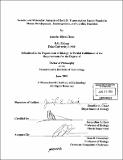| dc.contributor.advisor | Jacqueline A. Lees. | en_US |
| dc.contributor.author | Cloud, Jennifer Ellen, 1976- | en_US |
| dc.contributor.other | Massachusetts Institute of Technology. Dept. of Biology. | en_US |
| dc.date.accessioned | 2006-03-24T16:05:36Z | |
| dc.date.available | 2006-03-24T16:05:36Z | |
| dc.date.copyright | 2003 | en_US |
| dc.date.issued | 2003 | en_US |
| dc.identifier.uri | http://hdl.handle.net/1721.1/29593 | |
| dc.description | Thesis (Ph. D.)--Massachusetts Institute of Technology, Dept. of Biology, 2003. | en_US |
| dc.description | Includes bibliographical references. | en_US |
| dc.description.abstract | The E2F transcription factors are critical downstream targets of the retinoblastoma protein (pRB) pathway. A component of the pRB pathway is mutated in most human tumors resulting in deregulation of cell cycle control through the inappropriate release of E2Fs. E2F1, E2F2, and E2F3 are members of the "activating E2F" subfamily that is important for the transcriptional activation of target genes involved in DNA replication and cell cycle control. These E2F family members are essential for cellular proliferation in vitro. This study analyzes the role of the activating E2Fs in vivo using mutant mouse models. It demonstrates that E2F3 is essential for viability in a strain dependent manner. E2f3 animals die at three distinct time points from cardiac etiologies. The embryonic and neonatal lethality of these animals is consistent with proliferation defects in the myocardium that result in hypoplastic heart walls and septa. E2f animals that survive the perinatal period eventually die from highly penetrant, late-onset congestive heart failure. This is the first evidence that proliferation regulators have an important role in adult heart failure. In addition, this study examines the relative roles of E2F1 and E2F3 in vivo. It shows that E2F1 and E2F3 have functional overlap during mouse development as well as in the maintenance of a number of adult tissues. However, E2F1 appears to have a distinct function as a tumor suppressor gene. Importantly, E2F1 and E2F3 both contribute to normal cardiac function. Furthermore, mutation of the gene for the pRB protein that negatively regulates the activating E2Fs can rescue the heart failure in the E2f3 animals. These data argue strongly that proper regulation of proliferation is critical for adult cardiac function. | en_US |
| dc.description.statementofresponsibility | by Jennifer Ellen Cloud. | en_US |
| dc.format.extent | 167 leaves | en_US |
| dc.format.extent | 7461124 bytes | |
| dc.format.extent | 7460932 bytes | |
| dc.format.mimetype | application/pdf | |
| dc.format.mimetype | application/pdf | |
| dc.language.iso | eng | en_US |
| dc.publisher | Massachusetts Institute of Technology | en_US |
| dc.rights | M.I.T. theses are protected by copyright. They may be viewed from this source for any purpose, but reproduction or distribution in any format is prohibited without written permission. See provided URL for inquiries about permission. | en_US |
| dc.rights.uri | http://dspace.mit.edu/handle/1721.1/7582 | |
| dc.subject | Biology. | en_US |
| dc.title | Genetic and molecular analysis of the E2F transcription factor family in mouse development, tumorigenesis, and cardiac function | en_US |
| dc.type | Thesis | en_US |
| dc.description.degree | Ph.D. | en_US |
| dc.contributor.department | Massachusetts Institute of Technology. Department of Biology | |
| dc.identifier.oclc | 52915884 | en_US |
